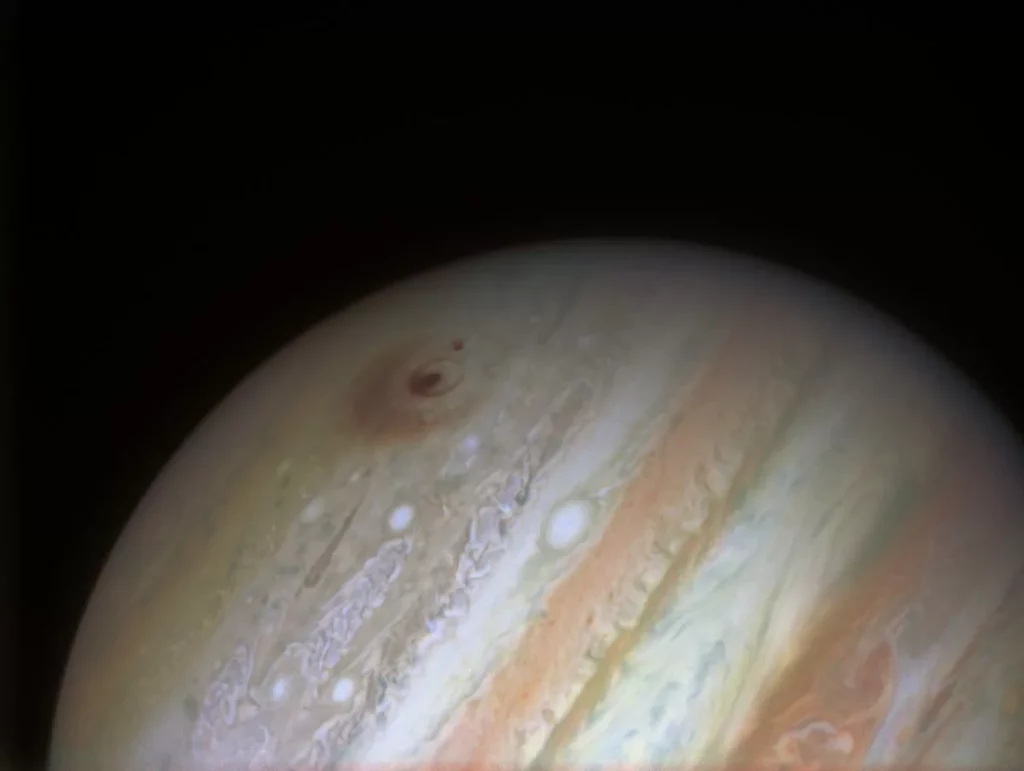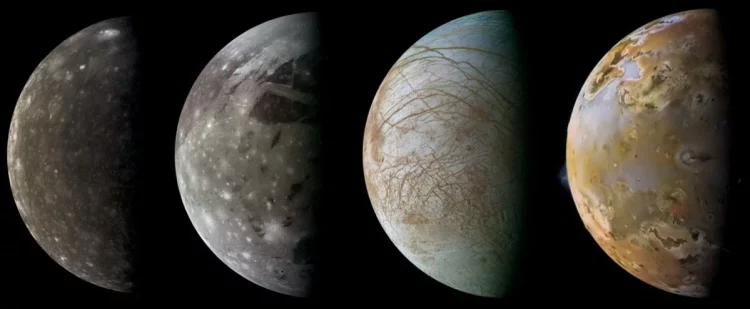Jupiter, the largest planet in the Solar System, is a colossal gas giant with a grandeur that dwarfs its planetary siblings. Its immense size, complex atmospheric phenomena, powerful magnetic field, and extensive moon system make it a focal point for scientific inquiry and exploration. This comprehensive guide explores Jupiter’s physical properties, atmospheric characteristics, magnetic environment, satellite system, and the historical and ongoing efforts to understand this magnificent planet.
I. Overview of Jupiter
1. Basic Facts
- Size and Mass: Jupiter is the largest planet in the Solar System, with a diameter of about 139,820 kilometers (86,881 miles). Its mass is approximately 318 times that of Earth, making it 1.9 times more massive than all the other planets combined.
- Orbit and Rotation: Jupiter orbits the Sun at an average distance of about 778 million kilometers (484 million miles). It has an orbital period of approximately 11.9 Earth years. Jupiter’s rotation is remarkably fast, completing one rotation in just about 9.9 hours, which contributes to its oblate shape.
- Axial Tilt and Seasons: Jupiter has an axial tilt of only 3.1 degrees, resulting in minimal seasonal variation compared to Earth. This minor tilt means that Jupiter’s equatorial and polar regions experience relatively uniform temperatures throughout its year.
2. Appearance
- Color and Bands: Jupiter is famous for its striking appearance, characterized by alternating bands of clouds in shades of white, orange, brown, and red. These bands, known as “zones” and “belts,” are the result of differential rotation and convective processes in Jupiter’s atmosphere.
- Great Red Spot: One of the most iconic features of Jupiter is the Great Red Spot, a colossal storm system that has been raging for at least 350 years. This anticyclonic storm is about 1.3 times the diameter of Earth and is a key subject of study for understanding Jupiter’s atmospheric dynamics.
II. Atmospheric Dynamics
1. Composition and Structure
- Atmospheric Composition: Jupiter’s atmosphere is primarily composed of hydrogen (about 90%) and helium (about 10%). Trace amounts of methane, ammonia, water vapor, and other gases are also present. This composition is similar to that of the Sun, reflecting Jupiter’s status as a gas giant.
- Cloud Layers: Jupiter’s atmosphere consists of several layers of clouds, primarily made of ammonia ice, ammonium hydrosulfide, and water. These clouds form distinct layers and contribute to the planet’s banded appearance.
- Temperature and Pressure: The temperature in Jupiter’s upper atmosphere averages around -145 degrees Celsius (-234 degrees Fahrenheit). However, temperatures increase dramatically with depth due to the planet’s internal heat, reaching thousands of degrees Celsius in the deeper layers.
2. Weather Systems
- Storms and Cyclones: Jupiter experiences some of the most intense and dynamic weather systems in the Solar System. These include the Great Red Spot, as well as other large storms and cyclones. The planet’s rapid rotation and differential heating contribute to the formation and persistence of these massive storms.
- Jet Streams: Jupiter’s atmosphere is characterized by strong jet streams that produce the planet’s distinctive banding. These jet streams are driven by the planet’s rapid rotation and the heat generated by its interior.
- Auroras: Jupiter’s strong magnetic field and rapid rotation generate intense auroras at the planet’s poles. These auroras are created by charged particles from the solar wind interacting with Jupiter’s magnetic field and atmosphere.
III. Magnetic Field and Radiation Belts
1. Magnetic Field
- Strength and Structure: Jupiter’s magnetic field is the strongest of any planet in the Solar System, about 14 times stronger than Earth’s magnetic field. The field is generated by the motion of metallic hydrogen in Jupiter’s interior, creating a complex and powerful magnetic environment.
- Magnetosphere: Jupiter’s magnetosphere extends millions of kilometers into space and contains a vast array of charged particles. The magnetosphere interacts with the solar wind and affects the space environment around Jupiter.
2. Radiation Belts
- Intense Radiation: Jupiter’s magnetic field traps high-energy particles, creating intense radiation belts around the planet. These radiation belts are far stronger than Earth’s Van Allen belts and pose significant challenges for spacecraft and potential future missions.
- Impact on Moons: The radiation belts influence the environment of Jupiter’s moons, particularly Io, Europa, and Ganymede. The high radiation levels can affect surface conditions and contribute to the moons’ geologic activity.

IV. Jupiter’s Moons
1. Galilean Moons
- Io: Io is the most geologically active body in the Solar System, with hundreds of active volcanoes and a surface covered in sulfur and sulfur dioxide. Its intense volcanic activity is driven by tidal heating caused by gravitational interactions with Jupiter and other Galilean moons.
- Europa: Europa is notable for its icy surface, which is believed to cover a subsurface ocean of liquid water. This ocean may harbor conditions suitable for life, making Europa a prime target for astrobiological studies.
- Ganymede: Ganymede is the largest moon in the Solar System, even larger than the planet Mercury. It has a magnetic field of its own and a surface that shows signs of both icy and rocky terrains. Ganymede is thought to have a subsurface ocean as well.
- Callisto: Callisto is the most heavily cratered of the Galilean moons and is thought to have a subsurface ocean of liquid water. Its surface is characterized by ancient, heavily cratered terrain, making it an interesting object for studying the early Solar System.
2. Other Moons
- Amalthea: Amalthea is one of Jupiter’s inner moons and is irregularly shaped. It is known for its reddish surface and is believed to be composed of porous ice and rock.
- Himalia: Himalia is one of Jupiter’s outer moons and is the largest member of a group of irregularly shaped moons known as the Himalia group. It is thought to be a captured asteroid.
- Thebe and Adrastea: These are two small inner moons of Jupiter, known for their irregular shapes and close orbits around the planet. They play a role in the dynamics of Jupiter’s ring system.
V. Exploration History
1. Early Observations
- Telescopic Discoveries: Jupiter has been observed since ancient times, but significant discoveries began with the advent of telescopes. Galileo Galilei’s observations in 1610 revealed Jupiter’s four largest moons, now known as the Galilean moons.
2. Space Missions
- Pioneer Missions: NASA’s Pioneer 10 and Pioneer 11 spacecraft, launched in the early 1970s, provided the first close-up images of Jupiter and its moons. These missions helped to confirm the existence of Jupiter’s rings and provided initial data on its atmosphere and magnetosphere.
- Voyager Missions: The Voyager 1 and Voyager 2 spacecraft, launched in 1977, conducted detailed flybys of Jupiter in 1979. They provided comprehensive data on Jupiter’s atmosphere, rings, and moons, and discovered active volcanism on Io and the potential subsurface oceans of Europa and Ganymede.
- Galileo Mission: Launched in 1989, the Galileo spacecraft entered orbit around Jupiter in 1995 and conducted detailed studies of the planet and its moons. Galileo’s observations confirmed the presence of subsurface oceans on Europa and Ganymede and provided extensive data on Jupiter’s atmosphere and magnetic field.
- Juno Mission: Launched in 2011, NASA’s Juno spacecraft entered Jupiter’s orbit in 2016. Juno’s mission is to study Jupiter’s atmosphere, magnetic field, and gravitational field to better understand the planet’s formation and evolution. The spacecraft has provided valuable insights into Jupiter’s atmospheric dynamics, magnetic environment, and interior structure.
3. Future Missions
- Europa Clipper: Scheduled for launch in the 2020s, NASA’s Europa Clipper mission will conduct detailed reconnaissance of Europa’s ice shell and subsurface ocean. The mission aims to assess the moon’s habitability and search for signs of life.
- JUICE Mission: The European Space Agency’s Jupiter Icy Moons Explorer (JUICE) mission, scheduled for launch in 2023, will study Jupiter’s moons, particularly Europa, Ganymede, and Callisto. JUICE aims to investigate the potential habitability of these moons and their geological activity.
VI. Scientific Significance
1. Understanding Gas Giants
- Planetary Formation: Studying Jupiter helps scientists understand the formation and evolution of gas giants. Jupiter’s composition and structure provide clues about the early Solar System and the processes that led to the formation of planetary systems.
- Atmospheric Dynamics: Jupiter’s complex atmospheric dynamics, including its weather systems and magnetic field, offer insights into the behavior of atmospheres on gas giants and other exoplanets.
2. Astrobiological Potential
- Moons and Life: Jupiter’s moons, particularly Europa, Ganymede, and Callisto, are considered key targets in the search for extraterrestrial life. Their subsurface oceans and geological activity make them intriguing candidates for studying potential habitable environments.


















































Discussion about this post